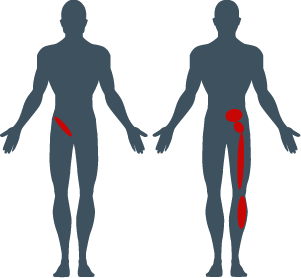MARCH 5, 2021
When is it Time to Seek Treatment for Low Back Pain?
Low back pain can cause extreme discomfort and affect your ability to complete daily activities. If you’re suffering from low back pain, even the simplest tasks, such as picking up a bag of groceries or tying your shoelaces, can feel overwhelming and cause pain. Most people don’t seek treatment for this condition because they think they can just “push through it,” but when do you know when it’s time to see a doctor?

In most cases, back pain dissipates about a week or two after an incident with over-the-counter anti-inflammatories and rest. However, if your pain is so severe that it keeps you from doing your usual daily activities and lasts for 6 weeks or longer, then it may be time to see a specialist.
What Causes Low Back Pain?
There are several reasons why you may be experiencing pain in your lower back. Common causes include:
- Muscle strain and ligament sprain
- Lumbar herniated disc
- Degenerative disc disease
- Spinal stenosis
- Osteoarthritis
- Sacroiliac (SI) joint dysfunction
Sacroiliac (SI) Joint Dysfunction and Back Pain
SI joint dysfunction is a common source of pain in many patients with pain in their lower back. Common signs and symptoms of SI joint dysfunction include:
- Dull, unilateral pain in the lower back
- Burning, numbness or tingling in the leg
- Pain that becomes worse and sharp while doing activities
- Feeling of leg instability
- Muscle tightness and tenderness in the hips or buttocks
- Low back pain and stiffness
- Disturbed sleeping patterns and sitting patterns due to pain
If you experience pain in the following areas with any of the above symptoms, then it may be time to seek treatment for SI joint dysfunction.

Common Treatments for Low Back Pain
When it comes to treatment, your healthcare provider may recommend non-surgical options at first. These often include physical therapy, chiropractic adjustments, massage therapy, prescription pain medications or steroid injections.
However, if SI joint dysfunction is to blame, then these treatments may not work or only provide temporary relief. If SI joint injections provide 75% or more pain relief, then SI joint dysfunction may be the source of pain. In these cases, more permanent treatment options are required.
Effective Treatment for SI Joint Dysfunction
While conservative treatments may reduce the inflammation and pain in your joint, you may still experience pain in your lower back or SI joint. If this is the case, your doctor may recommend the LinQ Stabilization System, a minimally invasive option for patients suffering from SI joint dysfunction.
LinQ works differently from other treatments. It doesn’t mask the pain, it addresses the source of it. LinQ works to stabilize the SI joint, helping to provide long-lasting pain relief. It is a minimally invasive procedure that involves just one single implant and one small incision. Patients typically leave the hospital the same day of surgery and can resume daily activities within a few weeks!
Want to Learn More About LinQ?
Low back pain isn’t always spine related. If you’ve had other treatments fail in the past, it may be because of your SI joint. Mention this to your doctor, then ask your doctor or contact PainTEQ today to learn more about LinQ, an innovative treatment method for SI joint dysfunction.



